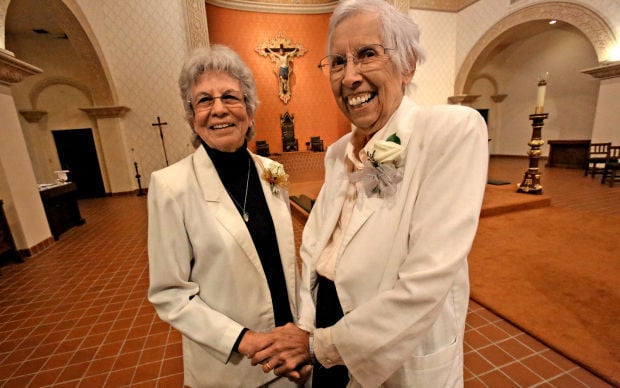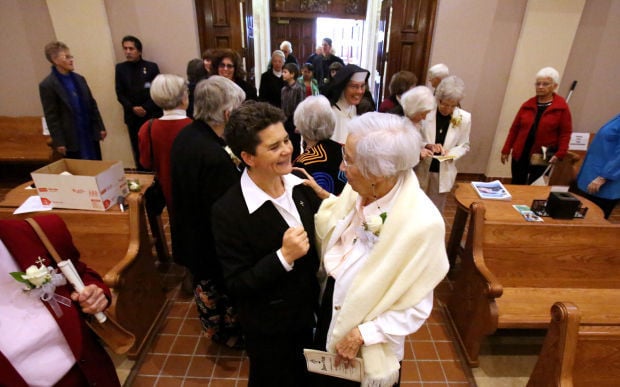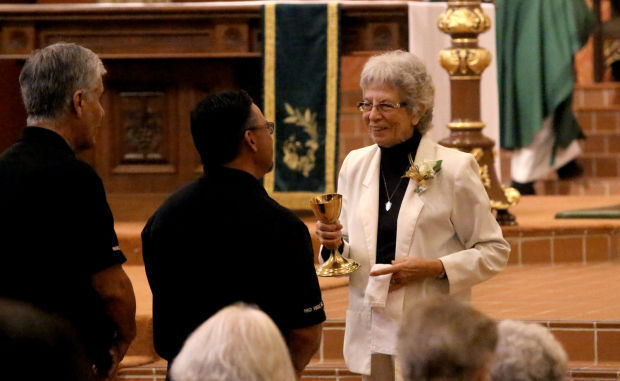Those who grew up in Barrio Santa Rosa near the Pio Decimo Center remember nuns, dressed in long, white habits, going in and out of their convent.
They called them the “White Sisters.”
Today, Sister Corina Padilla, 86, and Sister Esther Calderon, 77, are the last of the Eucharistic Missionaries of St. Dominic in Tucson. Earlier this month, both celebrated decades of vowed life — 65 years for Padilla and 50 for Calderon — at a jubilee Mass at St. Augustine Cathedral, 192. Stone Ave.
Their sisters, now called the Dominican Sisters of Peace, have served Arizona since 1939, teaching religious classes, visiting prisons, feeding the hungry and nursing the sick. And that’s just the beginning.
“I think their legacy has been a profound legacy,” says Guadalupe Castillo, who grew up in the neighborhood south of downtown around Pio Decimo, volunteered at the convent and took catechism classes from the nuns. “It is unsung in many ways, because their work was to be deeply rooted in our community ... and to lead us in understanding how to join in issues and what that really meant. It didn’t just mean praying. It meant doing.”
Castillo, 72, worked with Padilla throughout her career as a professor of history and Chicano studies at Pima Community College. The White Sisters, especially those who shared her Mexican-American heritage, were role models.
Both sisters grew up in small towns in Arizona, Padilla in Clifton and Calderon in Klondyke. Their vows took them out of state to New Orleans and Covington, Louisiana, respectively.
Padilla’s first mission brought her to Tucson in 1950 — a relief after spending the three years of training and formation away from Southern Arizona. She missed speaking Spanish, the language her family spoke at home. She says she cried of homesickness during her first year away.
In the decades since entering the congregation, both Padilla and Calderon have lived around the country and traveled abroad. Both came to and from Tucson over the years, eventually settling here permanently 20 to 25 years ago.
Both lived at Pio Decimo at one point. In the 1950s and 1960s, about seven sisters lived there, running a religious classes and ministering to isolated communities in the region. They often improvised. Padilla remembers one sister teaching out of a bus. She once taught in a chicken coop.
In 2009, the Eucharistic Missionaries of St. Dominic joined six other Dominican congregations to form the Dominican Sisters of Peace. Their numbers jumped from about 40 sisters to 655 all together, say Calderon and Sister Anne Lythgoe, the public relations administrator for the congregation.
Today, there are about 545 sisters, Lythgoe says. Calderon and Padilla believe less than 20 have ties to the Eucharistic Missionaries of St. Dominic.
When the Padilla and Calderon retire, so too will the work of the White Sisters in Arizona.
“YOU COULDN’T MISS US”
The Louisiana-based White Sisters came to Tucson in the 1930s at the request of the area’s bishop, Daniel Gercke.
“He was on a train, and our sisters were there, and of course you couldn’t miss us,” Padilla says of the women. “We were dressed in white, all white habits.”
When Gercke discovered that the 12-year-old congregation had been founded to serve poor communities, he wanted that for Tucson.
And so the ministry spread, with sisters working and visiting towns across the state: Phoenix, Globe, Douglas, Nogales, Bisbee, Clifton, Morenci, Duncan, Willcox and Safford, according to the Roman Catholic Diocese of Tucson.
In those small towns, Calderon and Padilla encountered their sisters for the first time as young women, attracted to the missionary spirit that took these nuns out of hospitals, schools and orphanages — customary roles for Catholic sisters — and into the heart of a community.
The Pio Decimo Center, 848 S. Seventh Ave., opened in 1946 with a convent for the nuns. Padilla and Calderon believe the sisters stopped living at the convent in the 1980s when their numbers dwindled.
“I used to see them washing their cars,” says Johnny Duran, whose mother still owns the family home in the neighborhood. Now 50, Duran remembers helping the nuns as a kid, struck by the image of these sisters in their white habits “out there washing the cars.”
Sometimes, they paid him a quarter. Sometimes, he did it for free.
Castillo remembers the sisters, including Padilla, organizing after-school classes, activities and field trips to spots such as Sabino Canyon.
“I don’t think there is a person who grew up in this neighborhood who doesn’t have those memories,” Castillo says.
GIVING UP DANCING
Before entering the congregation, Calderon always thought she would get married.
She was engaged twice, but both engagements were broken for insignificant reasons. “I guess the Lord was calling me to this life,” she says.
But it took her a while to get there. Living in Klondyke and “way out there in the boonies,” Calderon remembers a priest visiting the town each month to celebrate Mass, sometimes using the dance hall, sometimes visiting her family’s home.
“He was always saying, ‘Esther, why don’t you become a nun?’” she recalls. “I never knew what nuns were.”
As a young woman, she started working as a bookkeeper in Safford. She skipped Mass often, and her ex-seminarian boss faithfully chided her for it.
And then she started helping people.
“I started volunteering with giving out food and clothes to the poor working in the fields out there in Safford,” she says. “I wanted to do something social, connecting with people.”
The White Sisters happened to be in the area. In 1962, at the age of 24, she joined them.
“My family and my friends would say, ‘How are you going to give up dancing?’” she says. “That’s when I really started thinking that I need to be with people that have the same interests as I do. ... My friends by that time were just wanting to have fun, and I was wanting something else.”
TO WORK WITH THE POOR
The missionary zeal of the White Sisters also captured Padilla’s heart.
As a child in Clifton, her family had no car and lived about three miles from church.
“There was a lady who used to gather us and teach us, and we would have our own little church in our neighborhood,” she says. “We would say the rosary, and she had a little bell and she would ring the bell, and all the kids would come. She had a lot to do with my faith.”
Padilla says her faith truly began to blossom during a religious summer school when sisters from another congregation began teaching the Bible.
“I was fascinated listening to this,” Padilla says. “I actually had a real religious experience, a conversion experience.”
She graduated from high school, and in 1947 at the age of 18, she joined the community.
“I found out that’s exactly what I wanted, to really work with the poor and people who were marginalized,” Padilla says. “That was really the thing that got me going.”
“SOMETHING DIFFERENT”
Because their work keeps them moving — visiting hospice patients, nursing in hospitals, encouraging migrant workers — both sisters admit that pants make for easier ministry.
Calderon says they stopped wearing their habits for the same reason they started — to be more acceptable to the community. When the Eucharistic Missionaries of St. Dominic was founded in 1927, the sisters were doing unusual work for nuns. The habits gave them credibility.
In the years following the Second Vatican Council in the 1960s, street clothes made more sense in an era that emphasized empowering the laity.
“They spot us regardless of whether we are in a habit or not,” says Padilla.
“No makeup!” Calderon adds, laughing.
“Maybe that’s true,” Padilla continues, “But people seem to know that there is something different about us.”
Beyond showing compassion, the sisters have the professional skills to meet practical needs. Padilla has a bachelor’s degree in social work from Arizona State University, and Calderon is a registered nurse and has an associate’s degree in nursing from Pima Community College. She works for Carondelet Health Network’s hospice program.
Since the 1970s, Margo Cowan, a Pima County public defender, has brushed shoulders with Padilla through shared activism.
From immigration issues to grieving with families, “whatever the situation, Corina is there to comfort and to help the person who is suffering move through the suffering and have a sense of hope again,” Cowan, 65, says.
In the early 1970s, Padilla spearheaded the Diocese of Tucson’s first Hispanic office. Serving in English and Spanish has brought much joy to both sisters.
Theresa Russell, 54, met Calderon in a social justice class and attends Most Holy Trinity Catholic Church, 1300 N. Greasewood Road, with both women.
Twice a week, Calderon does prison visits to offer bilingual services and Holy Communion to inmates. Not long ago, Russell accompanied her.
“We walked through the gates there, and everyone knew her,” Russell says. “The inmates, they’re all yelling, ‘Hello!’ to her, like she’s their friend.”
“OUT OF A JOB”
Their goal has always been to put themselves out of work.
“We’ve done that very well,” Padilla jokes.
With their mother house in New Orleans, the Eucharistic missionaries scattered after Hurricane Katrina. Now, as part of the Dominican Sisters of Peace, most congregation facilities are based in states such as Kentucky, Ohio and Louisiana.
No one else is coming to Arizona.
“The hard reality is that our presence will disappear from places,” says Lythgoe, the Dominican Sisters of Peace spokeswoman. “I think that has been our mission all along. The goal is not job security for the sister. It is to do what is needed and leave behind other people who are doing the work.”
Because the Second Vatican Council allows laity to serve without entering vowed life, numbers are down all around, Calderon says. The number of U.S. sisters peaked around 181,421 in 1965. The roughly 50,000 sisters serving last year indicates a 72.5 percent decline, according to a report published by Georgetown University’s Center for Applied Research in the Apostolate in fall 2014.
“In our community, they always used to tell us that we should go to a place and work ourselves out of a job, to get people to do their thing so we don’t have to stay there forever,” says Calderon. “And that’s what we did.”
Today, both sisters are still involved. Calderon works with inmates, migrant women and children and hospice patients. Padilla is semi-retired.
“It means that I don’t get paid for what I do,” she says, laughing. “It’s volunteer work. It’s along with what Sister Esther is doing.”
Life without ministry would be boring.
“That has been very life-giving for me,” Padilla says. “Whether I do it in English or Spanish, I know that I’m doing something for the people.”






